January 20, 2016
Hyeyoun Choi (H): Hello, Jeff! I’m honored to have a talk about your works today. Could you please tell us about Battlefield Project?
Jeff Beekman (J): Battlefield Project was an investigation of memorial sites related to the U.S. Civil War. To provide a bit of context, this was our nation’s single deadliest conflict, between slave owning states in the South and non-slave owning states in the North. The North won, slavery was abolished, and the nation remained whole - all positive outcomes. Still, the legacy is complicated. The destruction of the South’s economic and transportation infrastructures continues to haunt us in the form of crippling poverty in certain areas, and though positive steps were made, we have yet to achieve true racial equality.
In visiting some of the memorialized Civil War battlefields across the U.S., I found them to be strange, highly negotiated spaces. While general agreement exists that the history these sites preserve is important, the complexities of how this history is presented and how the land has been changed has not been adequately explored. War colleges, run by our armed forces, make frequent use of these locations to teach our officers military history and tactics. Historians, archaeologists - scholars of every variety come to these sites in support of their research. And then there are the literally millions of tourists who visit annually, whose importance cannot be underestimated because it is their support that keep these parks open. These audiences come with disparate and often contrary purposes for doing so.
Battlefield Project started as a way that I could begin to make sense of all this, a way I could explore how particular memorializes sites have evolved from the scarred and blood soaked fields where thousands fell and died, to become the tourist attractions, running trails, archaeological dig sites, re-enactor playgrounds and even training fields for our future soldiers.
Beyond the projection work, shown at the CICA Museum, this series has grown to include more observational photographs as well. Still, the purpose with all these works remains the same - a compression between the past and present, where the relationship between site and memory, the present and the fleeting moment where the nation almost succeeded in tearing itself apart, can be investigated.
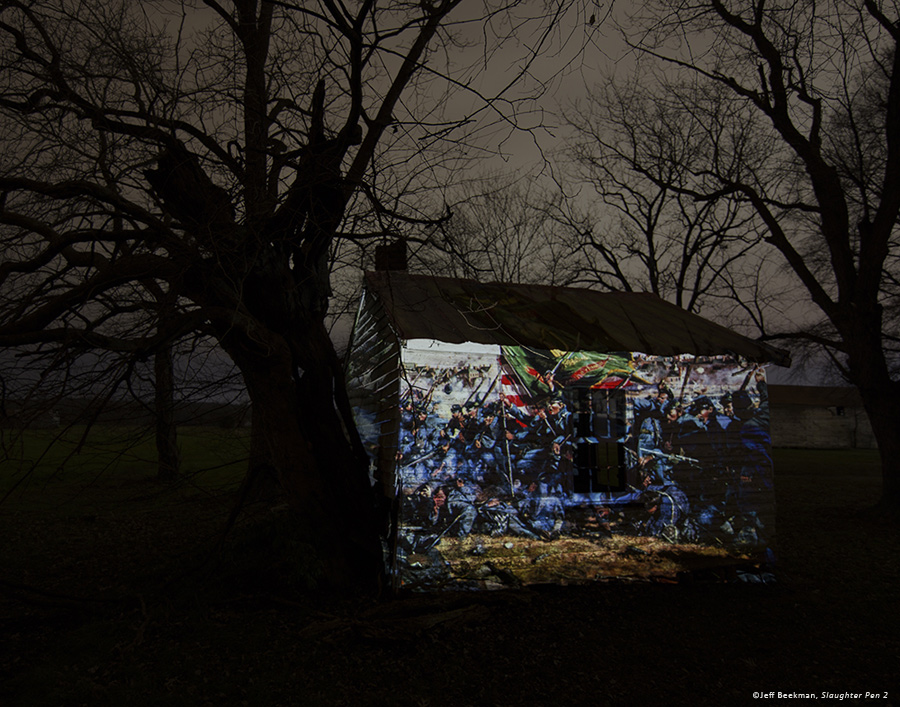
H: You mentioned in the artist statement that you do not use post-production collage such as combining the negatives or the Photoshop layering. And I also learned that the images of the wounded are from the six-volume archives by the U.S. Surgeon General in 1864. Could you explain more in detail how you achieve the final digital photo effect that merges into the landscape images?
J: These photographs were taken is the Fredericksburg & Spotsylvania National Military Park, where over 100,000 soldiers fell during the Civil War. I made the work over the course of three separate weeklong visits. Prior to arrival, I found images and prepared them for use as projections. Upon arrival, my days were spent exploring potential sites, taking photographs, learning more about the events that transpired there, and mentally composing photographs that I thought would be of conceptual and formal interest. At night, I would return with all my equipment to shoot more photographs. The equipment needed to complete the projection work was a laptop and a digital projector, a small table, and a portable gas generator to provide power. I would physically move the projections across the landscape until I felt the projected image began to integrate in an interesting way with the trees or structures they were cast upon. The results were then carefully captured with my camera in a single photograph.
In terms of the archives I used, I found myself drawn to images of common soldiers, whose contributions are usually less recognized in U.S. Civil War narratives then the generals or politicians. One of the sources I found was the medical archives of the U.S. Surgeon General you mention. These volumes contain photographic and textual documentation of experimental surgical treatments. Also included in these archives are biographies of the wounded men, including how and where they were injured. I used this information to relocate them back into the fields where they fell. This archive I found to be a very valuable resource, in that it cut along class lines, and presented soldiers from every rank and side in the fighting.
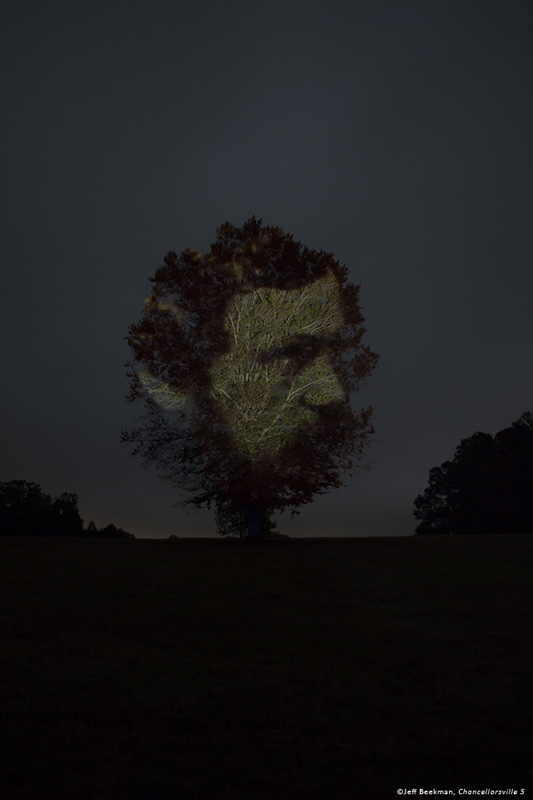
H: I see that you work with a diverse range of genres from more traditional painting and drawing to video, installation and architectural forms. What made you use photography for Battlefield Project? Do you usually decide which medium you would use first then the idea, or the other way around? Could you describe the creative process of Battlefield Project?
J: I am fairly organic in terms of how I develop new projects. Often the concepts I want to explore do come first, and then I figure out appropriate techniques and materials suited to these investigations. Other times I stumble upon a process or material that I am interested in, and then the explorations are more intuitive and playful. The projection works, like that shown at the CICA Museum, were initially a result of the later.
I began making projection works as an experiment while at an artist residency in Assisi, Italy. The sculptures in the landscape I was making were not doing what I needed them to in terms of adequately addressing the histories I wanted to explore, and I had been thinking a lot about the works of Polish artist Krzyzstof Wodiczko and U.S. artist Shimon Attie. (Both have used projections on specifically buildings as a means of discourse with the primarily urban environments into which their images are cast.)
The early experiments in Assisi were pretty in a way, but I don’t think they were all that interesting. Still, I realized I had found a process for making that could be both powerfully imposing and entirely ephemeral, a tension I really appreciate. When I returned to the U.S. I quickly came up with the idea of exploring battlefields. I have been working on this series since.
H: You projected the archival photographs of injured soldiers back into the physical locations where they were wounded in the Battlefield Project. What do you want the audience to feel or learn from your work?
J: The images contained within the medical archives are so horrific; that most viewers’ natural reaction would be to recoil from what they were seeing. I think almost instinctually, this recoil, this resistance to look, seems like an unsatisfactory reaction to have when encountering evidence of another human being in pain. My goal was to overcome the recoil, and instead present these figures in a way where viewers would be willing to spend time with the figures represented, to empathize with them, hopefully to allow a sense of dignity to the men, all the while still providing indications that there was real brutality to the injuries they sustained.
H: Including Battlefield Project, many of your works encompass significant history. Is there a reason behind implicating historical meanings to artworks? I mean, do you have a grandiose mission for creating artworks or you just feel like doing it?
J: Our social customs, our architectures, the languages we use – these and so much more are the direct result of events in our collective pasts. To be ignorant to our pasts, our histories, this limits us to living reactionary lives. Alternatively, when we begin to know our histories, how and why things have taken they shape they have, why people are reacting the way they are, that’s context and power. It allows for deeper understanding and a greater appreciation of who we are, and when you learn about others histories it usually provides a reason to be gentle with others even when you do not agree with what they are doing.
I wouldn’t say I make work with a grandiose mission. I make work as a way to think with my hands and with my eyes. Think in ways my brain isn’t perhaps best equipped to handle.
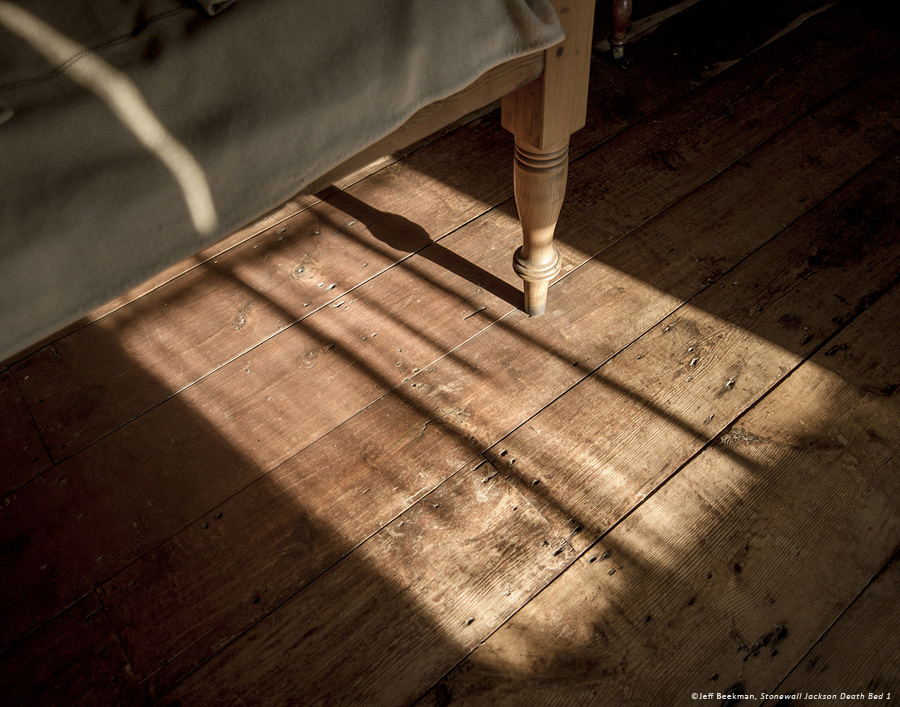
H: Do you think any of your childhood shaped you this way? Have you always been interested in history?
My father died when I was two years old. While my twin sister and I were too young to really remember him, my older siblings and mother were definitely affected by his death in a variety of ways. I think from an early age my sister and I sought to figure out who our father was, what we lost, and what he meant to those left behind. Photographs were important tools, but more important were the stories. You can learn a lot from what others say, and sometimes even more from those moments when the speaking stops. I see all explorations of history like that. It is about asking questions, and then piecing things together with the knowledge you’ll never get things totally right. Life is too messy for that.
H: Do you think art, in general, should be historical? What is “good art” to you?
J: I don’t think artwork should be historical. I think artwork is unavoidably historical. And, if you try to approach art without taking into account the time and place and social conditions that gave birth to it, then I think you are probably missing the point. For instance, Marcel Duchamp displaying a urinal in the center of a gallery in 1917 (a work commonly cited as the most important artwork of the last century), is simply a juvenile prank until you understand this action was done in the middle of WWI by a frustrated exile living abroad while his brothers and friends were fighting and his home was being bombarded by German airplanes. In this context we can better understand why he made this artwork, why he did this ridiculous and aggressive act that challenged the sanctity of the gallery as a space. Anything than making work that screamed at this moment in time would have been dishonest for him. Understanding the historical context is everything.
Good art? Wow, I don’t know how to define that. There is work that I respond to, work that I think asks really interesting questions, work whose craft or emotional power leaves me feeling awestruck. I teach at a university in the U.S., and one of the benefits I have found from working with students is that you quickly realize there is no universally recognized template for what quality artwork is. There is what works for you, and I think this evolves and changes, and this is a good thing.
H: I know that you have exhibited in China and Vietnam but this is the first time having a show in Korea. How do you feel about showcasing Battlefield Project in Seoul?
J: I am honored to have my work exhibited at the CICA Museum, and to have the opportunity to share my work with Korean audiences for the first time. I also appreciate the opportunity you are providing, the chance to speak with you about my work.
H: Korea has a very complicated history of its own. We suffered from dictatorship by Japan, and have been divided into North and South since Korean War. Are you interested in Asian history as well?
J: Some of my favorite and most vivid memories are of times spent in Asia - riding across the Gobi Desert in Inner Mongolia by camel; going with an artist friend to a rural area of Vietnam to photograph where her American brother was stationed as a soldier in the 1970’s before he committed suicide; the kindness shown to me by a Buddhist nun at the Angkor Wat complex, who insisted on cleaning and wrapping up my foot after I cut it open on a sharp stone. I have learned so much from every place I have been fortunate enough to travel, and extending the experience by learning the history of these places, where they came from, what challenges they face and what they accomplished in spite of these challenges – this makes any experience richer. I have no doubt I would learn much from time spent in Korea. I have not really had the opportunity to visit yet, but if have the opportunity I would not hesitate.
H: Any future artwork plan?
J: I am definitely continuing the photographic work, and would like to see the Battlefield Series evolve in ways that recognize particularly the efforts of African-American soldiers during the Civil War. We know by the war’s end African-American men accounted for 10% of the North’s military force, but they are largely ignored in most of the photo archives, and neither are they adequately honored in existing Civil War memorials. I have not yet figured out how to make photographic works about what is not present, but it is an interesting question that I am looking forward to exploring.
Jeff Beekman
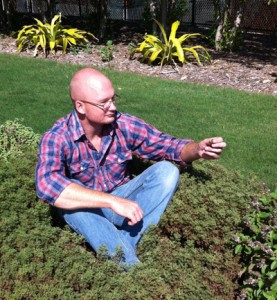 Jeff Beekman, is a multidisciplinary artist and teacher whose artwork since the early 2000's has explored the interrelationships between land, memory and human activity. His work has been exhibited at venues across the U.S., as well as in New Zealand, Australia, China, Vietnam, England and South Korea. Jeff is currently an Assistant Professor at Florida State University, where he also serves as Director of Foundations and B.A. Programs.
Jeff Beekman, is a multidisciplinary artist and teacher whose artwork since the early 2000's has explored the interrelationships between land, memory and human activity. His work has been exhibited at venues across the U.S., as well as in New Zealand, Australia, China, Vietnam, England and South Korea. Jeff is currently an Assistant Professor at Florida State University, where he also serves as Director of Foundations and B.A. Programs.
Hye-Youn Choi
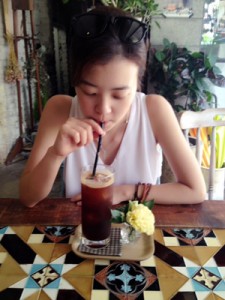 Hye-Youn Choi is a Seoul-based curator. She is also a painter who showcased her works in Seoul, Montreal, and in Los Angeles. She is currently pursuing an MA in Arts Administration at Seoul National University. She received her BFA in Painting & Drawing and Art History from Concordia University in Montreal, Canada.
Hye-Youn Choi is a Seoul-based curator. She is also a painter who showcased her works in Seoul, Montreal, and in Los Angeles. She is currently pursuing an MA in Arts Administration at Seoul National University. She received her BFA in Painting & Drawing and Art History from Concordia University in Montreal, Canada.
H: 안녕하세요, Jeff씨! 이렇게 작품에 대해 함께 얘기하게 되어서 영광입니다. 먼저, Battlefield Project에 대해 설명해 주실 수 있을까요?
J: Battlefield Project는 미국의 남북전쟁 기념지구를 탐구하는 작품입니다. 역사적 배경을 조금 설명하자면, 남북전쟁은 노예제도를 찬성하는 남부와 반대하는 북부의 미국 역사상 가장 치열한 갈등이었습니다. 결과적으로 북부가 승리하고, 노예제도는 폐지되고, 국가 또한 분열되지 않고 단합되는 등, 모든 것이 긍정적으로 매듭지어졌지만, 그 잔해는 여전히 남아있습니다. 당시 남부의 경제와 교통 인프라가 무너지는 바람에 여전히 남부의 몇몇 지역은 가난의 고통에 시달리고 있으며, 인종 차별 문제 역시, 긍정적인 변화에도 불구하고 아직까지 진정한 의미의 인종 평등을 이뤄냈다고 하기엔 무리입니다.
저는 미국의 남북전쟁 기념지구를 방문했을 때, 그 곳이 지나치게 타협된, 이상한 장소라고 생각했습니다. 그 장소에 담겨진 역사는 매우 중요한 것임에도 불구하고, 그 역사를 향유하는 방식이나 땅을 개조하는 등의 방법은 전혀 그 장소의 역사적 가치와 걸맞지 않았던 것입니다. 군대에서는 전쟁 참전용사들이 자주 이 장소를 이용해 군대의 역사나 전법을 전수하고, 역사학자와 고고학자와 같은 다양한 분야의 학자들은 자신들의 연구를 위해 이 곳을 찾습니다. 그리고 매년, 이 전쟁기념지구의 운영을 유지해주기에 더욱 소중한, 수백만명의 관광객들이 찾아옵니다. 결국, 관람객들은 모두 서로 다른 목적을 가지고 이 장소를 방문하게 되는 것입니다.
Battlefield Project는, 이 모든 것들은 한 데 묶는 것으로 시작되었습니다. 수천만에 이르는 사상자의 피와 상처로 가득한 맨 땅이 어떻게 해서 관광지로, 조깅 장소로, 고고학자들의 연구 장소로, 또 미래 군인들의 훈련장소로 쓰이게 되었는지 탐구하는 것입니다.
CICA 미술관에 전시된 프로젝션 작품 외에, 이 시리즈는 많은 사진 작품으로 이루어져있습니다. 하지만 작품의 목적은 모두 같습니다. 바로 과거와 현재를 한 데 묶는 것으로, 국가 스스로 특정 장소에 얽힌 과거의 기억과 현재의 순간들을 이어주는 연결고리를 차단해낸 이 남북전쟁 기념지구를 탐구하는 것입니다.

H: 제프씨는 사진의 네거티브를 겹치거나, 포토샵의 레이어 기능 등 완성된 사진으로 콜라주하지 않는다고 말씀하셨는데요. 또한, 작품 속 부상자들의 사진이 1864년 미군의관이 보관해온 6권에 이르는 아카이브에서 발췌된 것이라고 했는데, 어떻게 해서 전쟁기념지구 풍경 위에 부상자들의 얼굴을 담은 사진이 나올 수 있었던 건지 자세히 설명해주실 수 있을까요?
이 (풍경) 사진은 Fredericksburg & Spotsylvania 국립군사공원에서 찍은 것입니다. 남북전쟁동안 10만 명의 군사들이 생명을 잃은 곳이죠. 저는 각각 일주일 동안 세 번에 걸쳐 군사공원을 방문하였는데, 방문하기 전, 현장에서 프로젝션할 이미지를 찾아 들고 갔습니다. 공원에 방문해서는 현장 조사를 하고, 사진을 찍고, 그 곳에서 일어난 사건들에 대해 조사하면서 사진 이미지를 머리속으로 구상했습니다. 그리곤 밤에, 장비를 챙겨 돌아와 촬영을 진행했습니다. 프로젝션 작품을 위해 쓰인 장비는 노트북과 디지털 프로젝터, 작은 테이블, 그리고 휴대용 가스 충전기였습니다. 저는 풍경 위에 이미지를 프로젝션으로 쏘아 보며 주변의 환경과 이미지가 어울리는 지점을 찾았고, 이후 프로젝션 이미지를 입힌 풍경을 카메라로 단 한 번, 매우 세심하게 촬영하였습니다.
아카이브 이야기를 하셨는데, 저는 남북전쟁을 돌아봤을 때, 장군이나 정치인과는 달리 대체로 공로를 인정받지 못한 평범한 군인들에게 관심이 갔습니다. 그리곤 발견한 것이 혜윤씨가 말씀하신 미군의관의 아카이브였죠. 거기엔 당시 실험적이었던 수술에 대한 사진과 텍스트 설명과 함께 부상당한 사람들의 프로필, 그들이 어디서 어떻게 다쳤는지까지 상세히 기록되어 있었습니다. 저는 이 정보를 이용해 그들의 이미지를 그들이 부상당한 지점에 배치하였습니다. 저는 계급을 떠나 전쟁에 참여한 모든 군인들을 보여주는 이 아카이브가 매우 가치있는 것이라고 생각합니다.

H: 제프씨는 전형적인 페인팅부터 드로잉, 비디오, 설치, 그리고 건축까지 다양한 장르를 넘나들며 작업하시는 것으로 알고있는데요, Battlefield Project를 포토그래피로 진행한 이유가 있을까요? 보통 어떤 장르/재료로 표현할지 먼저 정하고 아이디어를 구상하는 편이신가요, 아니면 그 반대의 순서인가요? Battlefield Project의 제작 과정을 설명해 주세요.
J: 저는 꽤나 유동적으로 새로운 프로젝트를 진행합니다. 대개는 탐구하고픈 컨셉이 먼저 떠오르고, 그것을 실행할 적절한 테크닉과 재료를 고민합니다. 혹 때로는 특정 제작 과정이나 재료에 관심이 먼저 가기도 하는데 이 경우 이후 진행 과정은 좀 더 직관적이고 재미나죠. 현재 CICA 미술관에 전시되어있는 프로젝션 작품은 후자의 경우에 해당됩니다.
저는 이태리 아시시에서 레지던시 아티스트로 지내면서 실험적으로 프로젝션 작품을 만들기 시작했습니다. 풍경 속에 조각품을 설치하는 것만으로는 제가 탐구하고자하는 역사적 의미가 제대로 전달되지 않는 것 같아 그때부터 폴란드 아티스트인 Krzyzstof Wodiczko와 미국의 아티스트인 Shimon Attie의 작품에 대해 고찰하게 되었습니다. (이 두 아티스트 모두 도시의 환경에 이미지를 입히는 식의, 특별히 빌딩에 프로젝션을 쏘는 작업을 합니다.)
아시시에서 했던 초기 실험들은 꽤 성공적이었지만, 흥미로운 작업은 아니었다고 생각합니다. 하지만 그래도 메세지 전달이 강력하면서도 동시에 손에 잡힐 듯 말듯한 제작과정을 찾은 듯 했고, 그 둘 사이에서 일어나는 긴장감은 매우 만족스러웠습니다. 이후 미국으로 돌아와 전장에 관한 아이디어를 탐구하기 시작했고, 그때부터 계속 이 시리즈를 작업해 왔습니다.
H: Battlefield Project에서 부상당한 군인들의 아카이브 사진을 그들이 부상당한 장소에 배치하였는데요, 이 작품을 보고 관람객들이 무엇을 배우고 느끼길 바라나요?
J: 의학 아카이브 안의 이미지들은 매우 끔찍합니다. 그렇기에 사실 많은 관람객들은 자연스레 이미지를 보고 움찔하여 피하게 될 것입니다. 이렇게 이미지를 피하는 것은, 직감적으로 생각하건데, 흔히 다른 이의 아픔을 마주하였을 때 나타나는 반응처럼 느껴집니다. 저는 군인들의 이미지를 보여줌으로써 그들의 부상에 얽힌 인간의 무자비함을 놓치지 않으면서도, 관객들이 느끼는 자연스런 적대감을 넘어서서, 자신들의 눈앞에 마주한 이미지를 관찰하며 시간을 보내고, 그들의 아픔에 공감하고, 나아가 인간을 향한 존엄성을 느끼게 되었으면 합니다.
H: Battlefield Project를 포함해서, 제프씨의 작품 다수가 중요한 역사적 메세지를 담고 있는데요, 작품 속에 역사를 반영하는 특별한 이유가 있나요? 이러한 역사적 작품활동에 대한 사명감을 갖고 있는건지, 아니면 그때그때 느끼는 대로 작업하는 것인지요?
J: 우리가 현재 향유하는 사회적 관습, 건축물, 언어 등은 모두 과거의 산물입니다. 그렇기에 우리의 과거와 역사를 잊고 사는 것은 현재의 우리의 삶을 위축시키는 것과 같다고 생각합니다. 다시 말해, 과거의 일들이 어떻게 하여 현재의 우리를 만들었는지, 왜 사람들이 특정한 방식으로 반응하는지, 역사의 맥락을 알면 알수록, 지식의 힘이 생기는 것입니다. 이 지식은 우리 자신이 누구인지에 대해 더 깊이 고찰하고 이해하고, 또 감사할 줄 알게해줄 뿐 아니라, 개인적으로 이해할 수 없는 행동을 할 지언정 타인을 이해하고 배려해야하는 정당성을 일깨워줍니다.
특별한 사명감을 가지고 작품활동을 한다고는 말하지 않겠습니다. 저는 제 두 손과 두 눈으로 사고하기 위해 작품활동을 합니다. 어쩌면 뇌는 모든 것을 감당하기엔 충분하지 않다고 생각됩니다.

H: 제프씨가 이토록 역사에 관심이 많은 것이 어린시절과 관련이 있나요? 언제부터 역사에 관심을 갖게 되었나요?
J: 저희 아버지는 제가 두살 때 돌아가셨습니다. 저희 쌍둥이 남매는 너무 어렸기에 아버지를 잘 기억하지 못하지만, 저의 큰 형제들과 어머니는 아버지의 죽음에 여러 방면으로 영향을 받을 수 밖에 없었습니다. 제 생각에 저희 쌍둥이 남매는 어릴 때부터 아버지가 누구였는지, 우리가 잃은 것은 무엇인지, 남은 우리들에게 아버지는 무엇을 의미하는지를 알고싶어했던 것 같습니다. 이 질문들에 대한 답을 찾는 데에는 사진도 큰 역할을 했지만, 무엇보다 중요했던 것은 바로 전해듣는 이야기였습니다. 다른 사람들이 무언가에 대해 말할 때, 심지어 그들이 말을 잇지 못하고 멈출 때에는 더 많은 것들을 알 수 있기 때문입니다. 저는 모든 역사에 대한 탐구를 같은 방식으로 대합니다. 수많은 질문을 통해 얻은 답을 지식을 통해 실을 꿰어가는 것이죠. 하지만 절대로 완벽하게 이루어낼 수는 없습니다. 인생은 그렇게 간단하지 않으니까요.
H: 제프씨는 일반적으로 예술이란 역사적인 메세지를 담고 있어야 한다고 생각하나요? 당신에게 “좋은 예술" 은 무엇인 가요?
J: 저는 예술이 꼭 역사적인 메세지를 담고 있어야한다고 생각하지 않습니다. 오히려, 예술은 역사적 의미를 내포하고 있을 수밖에 없다고 생각하죠. 우리가 예술작품을 대할 때, 작품이 탄생한 시대적, 사회적 상황을 고려하지 않는다면 작품을 전혀 다르게 이해하게 될 것입니다. 예를 들어, 20세기 가장 중요한 작품으로 손꼽히는 Marcel Duchamp(마르쉘 뒤샹)이 1917년에 갤러리 정중앙에 선보인 소변기를 생각해 봅시다. 당시 세계1차대전이 진행중이었고, 마르쉘 뒤샹은 외국 피난민이였으며, 그의 형제들과 친구들은 전쟁터에 나가있고 그의 집은 독일 폭격기에 의해 완전히 붕괴되었었다는 사실을 간과한다면, 이 작품은 그저 철없는 장난으로 치부될 것입니다. 하지만 이러한 역사적 배경을 알게되면, 그가 왜 이러한 작품을 만들었는지, 왜 갤러리의 위생을 침범하는 터무니없고도 공격적인 행동을 했는지 이해할 수 있게 되는 것입니다. 마르셍 뒤샹이 이와 달리 별다른 외침 없는 작품을 만들었다면, 오히려 그것이야말로 스스로에게 솔직하지 못했던 것이었을 테죠. 이렇듯, 역사적 배경을 이해하는 것은 매우 중요합니다.
좋은 예술? 음, 어떻게 정의해야할지 모르겠습니다. 제가 반응하게 되는 작품이 있고, 제게 매우 흥미로운 질문들을 던지는 작품이 있고, 장인기술이나 혹은 감정전달이 너무나 강력해서 제가 경이로움에 사로잡히게끔 하는 작품이 있죠. 저는 미국의 한 대학교에서 예술을 가르치고있는데, 학생들과 함께하다보면 모든 작품에 통용시킬 수 있는 보편적인 기준이란 존재하지 않는다는 것을 금방 깨닫게 됩니다. 개개인마다 좋은 예술이 따로 있고, 그 기준이나 취향 또한 진화하고 또 변화한다고 생각합니다. 그렇기에 더 좋은 것이죠.
H: 제프씨가 중국과 베트남에서 전시했지만, 한국은 처음인 것으로 알고 있습니다. 서울에서 처음 Battlefield Project를 선보이셨는데, 기분이 어떠신가요?
J: CICA 미술관에서 전시하면서 처음으로 한국 관람객들에게 작품을 선보일 수 있는 기회가 주어져 영광입니다. 더불어 이렇게 제 작품에 대해 대화할 수 있는 기회를 마련해 주셔서 감사합니다.
H: 한국은 매우 복잡한 역사를 가진 나라입니다. 일제강점시기를 지나 한국전쟁을 거쳐 현재까지도 북과 남으로 분단되어있죠. 아시아 역사에도 관심이 있으신가요?
J: 제가 가장 좋아하고 선명히 기억하는 경험들 중 대부분이 아시아에서 보낸 시간들입니다. 몽골에서 낙타를 타고 고비 사막을 다닌 것, 제 아티스트 친구와 함께 베트남 시골을 다니면서 사진을 찍은 것 (그녀의 미국인 오빠는 1970년대 징병되었다가 이후 자살하고 말았습니다), 앙코르와트에서는 날카로운 돌에 발을 찢겼을 때 제 발을 닦아주고 치료해준 불교도인의 친절함을 느낀 것 등이 그러하죠. 제가 여행한 곳 모두에서 많은 교훈을 얻었습니다. 그들은 어디서 와왔는지, 어떠한 어려움이 있었고 그것들을 어떻게 이겨냈는지 등 그 곳의 역사를 배우면서 여행 장소에서의 경험이 훨씬 더 풍부해졌습니다. 저는 한국에서도 똑같이 많은 것을 배울 수 있을 것이라 생각합니다. 아직까지는 한국을 방문할 기회가 없었지만, 추후에 기회가 생긴다면 망설임 없이 떠날 것입니다.
H: 앞으로의 작업 계획을 얘기해주실 수 있을까요?
J: 사진 작업을 계속할 것이고, 특별히 남북전쟁 때 아프리카계 미국인들의 공로를 인정해줄 수 있는 형태로 Battlefield 시리즈를 이어갈 생각입니다. 남북전쟁 막바지에 아프리카계 군인들의 수가 북부 전체 군인수의 10%나 차지했지만, 그들 대부분은 사진 아카이브에 기록되지도 않았을 뿐더러 현존하는 남북전쟁 기념관에서도 제대로 인정받지 못하고 있습니다. 존재하지 않는 이미지로부터 어떻게 사진 작업을 해 나갈지는 아직 답을 찾지는 못했지만, 제가 앞으로 탐구해나갈 흥미로운 문제입니다.
Jeff Beekman
 Jeff Beekman은 여러 분야에 걸친 아티스트이자 교육자이다. 2000년도 초기부터 그의 작업은 장소, 기억, 그리고 인간의 행동에 얽힌 연관성을 탐구해오고 있다. 그의 작품은 미국 전역 뿐 아니라 뉴질랜드, 호주, 중국, 베트남, 영국, 그리고 한국에서 소개된 바 있다. Jeff는 현재 프롤리다 주립 대학교의 교수이자 미술학부의 디렉터로 역임하고 있다.
Jeff Beekman은 여러 분야에 걸친 아티스트이자 교육자이다. 2000년도 초기부터 그의 작업은 장소, 기억, 그리고 인간의 행동에 얽힌 연관성을 탐구해오고 있다. 그의 작품은 미국 전역 뿐 아니라 뉴질랜드, 호주, 중국, 베트남, 영국, 그리고 한국에서 소개된 바 있다. Jeff는 현재 프롤리다 주립 대학교의 교수이자 미술학부의 디렉터로 역임하고 있다.
Hye-Youn Choi
 최혜윤은 서울에서 활동하고 있는 큐레이터이자 아티스트이다. 그녀의 페인팅은 서울, 몬트리올, 그리고 로스엔젤레스에서 전시된 바 있다. 현재 서울대학교에서 예술경영 석사학위 과정을 밟고 있으며, 캐나다에 몬트리올에 위치한 콩코디아 대학교에서 페인팅&드로잉과 미술사 학위를 취득했다.
최혜윤은 서울에서 활동하고 있는 큐레이터이자 아티스트이다. 그녀의 페인팅은 서울, 몬트리올, 그리고 로스엔젤레스에서 전시된 바 있다. 현재 서울대학교에서 예술경영 석사학위 과정을 밟고 있으며, 캐나다에 몬트리올에 위치한 콩코디아 대학교에서 페인팅&드로잉과 미술사 학위를 취득했다.
